The Indian Peafowl, or more popularly, the Indian Peacock, is a bird that needs no grand introduction. With its shimmering blue neck, dazzling green train, and dramatic fan display, it’s no wonder this majestic bird is India’s national bird.
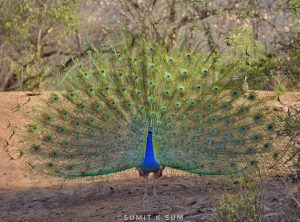
Often seen strutting through palace gardens, forest trails, or even village rooftops, the Indian Peafowl is more than just a pretty face. It’s a creature steeped in culture, mythology, and raw natural charisma — a living symbol of grace and grandeur and loved by all Nature Storytellers.
How to Identify Indian Peafowls
Let’s get one thing straight — only the males are called peacocks. Females are known as peahens, and both are members of the peafowl species. Together, they make up a stunning sight.
Here’s how to tell them apart:
🦚 Peacock (Male)
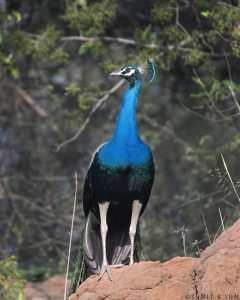
| Iridescent blue neck and breast |
| A magnificent greenish-gold train (not actually a tail) that can reach up to 6 feet |
| Eye-like markings (“ocelli”) on the train feathers |
| A crown-like crest on the head |
| Long legs, sharp spurs, and loud, far-carrying calls |
🐦 Peahen (Female)
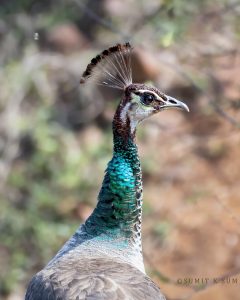
| More muted colours — brown and grey overall |
| Shorter tail, no extravagant train |
| Still has a small crest and elegant posture |
| Known for being fiercely protective of her chicks |
🐣 Peachick (Chick)
| Small, fluffy, and brownish-yellow |
| Camouflaged for ground-dwelling survival |
| Grows rapidly and starts flying short distances within weeks |
When a peacock fans out his train in full display — shimmering, rattling, and shimmering again — it’s one of the most dramatic courtship dances in the animal kingdom.
Distribution and Habitat of Indian Peafowls
The Indian Peafowl is native to the Indian subcontinent, and its natural range includes:
| India (widespread) |
| Sri Lanka |
| Nepal |
| Pakistan |
| And introduced populations in Australia, USA, and Africa |
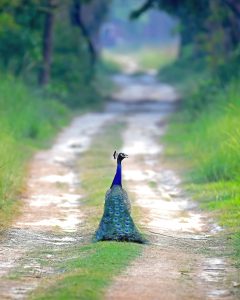
You’ll most often find them in:
| Deciduous forests and scrublands |
| Village outskirts and agricultural fields |
| Temple grounds and palace gardens |
| Protected sanctuaries and national parks |
They prefer places with open ground for display, dense underbrush for cover, and nearby water sources. Though wild at heart, they’re very comfortable living near humans, like purple sunbirds — often seen perched on rooftops or calling from boundary walls.
Indian Peafowl’s Behaviour and Diet
Indian Peafowl are ground birds, despite their strong flight. They usually roost in tall trees at night and spend their days foraging, calling, and — in the case of males — showing off.
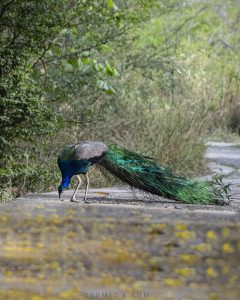
Their daily activities include:
| Foraging | They eat a mix of seeds, berries, fruits, insects, small reptiles, and even snakes! |
| Dust bathing | Keeps feathers clean and parasites away |
| Calling | Their loud, harsh cries often announce rain or danger |
| Displaying | Males perform elaborate dance routines during the breeding season |
Both the Indian Eagle Owl and the Peafowl are known for their distinctive calls echoing through the landscape. They are also known for their sharp alarm calls that alert other wildlife to predators like leopards or snakes — earning them a place as jungle watchmen.
Breeding and Nesting in Indian Peafowls
The breeding season in most parts of India falls between April and September, peaking during the monsoon.
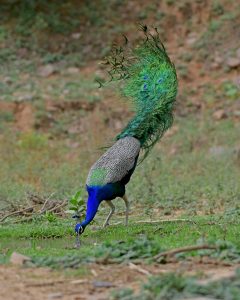
Courtship:
- Males gather in a lek (a group of displaying males), each showing off to attract females
- The train is fanned out, shaken, and even angled toward the sunlight for maximum shimmer
- A successful display can win the attention of multiple females
Nesting:
- The peahen lays 3–6 eggs in a shallow scrape on the ground, hidden in thick undergrowth
- Incubation lasts about 28 days, done solely by the female
- Chicks are precocial — they walk and feed themselves within days
Despite ground-nesting, the female’s camouflage and vigilance keep the clutch surprisingly safe.
Read about Another Beautiful Tall Bird – Sarus Crane
Cultural Significance of Indian Peafowls
The Indian Peafowl is deeply woven into the cultural, religious, and artistic fabric of India.
- In Hinduism, the peacock is associated with Lord Kartikeya (god of war) and often seen as the vehicle of Saraswati, the goddess of wisdom.
- In Buddhism, it symbolizes compassion and openness.
- Ancient and modern Indian art is filled with peacock motifs — from temple carvings to textile prints.
- In folklore, its cry is believed to bring rain, and its feathers are said to ward off evil spirits.
It is also a symbol of royalty and prosperity, often featured in palaces, jewellery, and festivals.
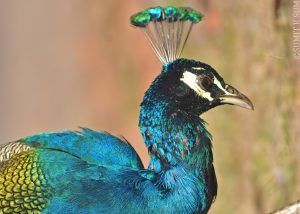
Peafowl vs. Peacock vs. Peahen — What’s the Difference?
| Term | Meaning |
| Peafowl | The species (includes both males and females) |
| Peacock | The male, with the iconic train |
| Peahen | The female, more camouflaged and protective |
| Peachick | A baby peafowl (chick) |
So, while “peacock” is often used generically, the correct name for the species is Indian Peafowl (Pavo cristatus).
Conservation Status of Indian Peafowl
Good news — the Indian Peafowl is listed as Least Concern by the IUCN. Populations are currently stable and even thriving in many parts of India.
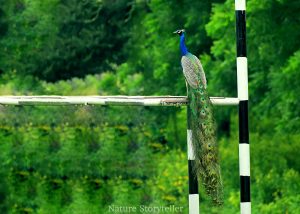
However, it does face local threats like:
- Poaching for feathers and meat
- Habitat degradation due to farming and development
- Pesticide poisoning, especially in agricultural areas
The species is protected under Schedule I of the Indian Wildlife Protection Act, meaning it enjoys the highest level of legal protection.
Fun Facts about Indian Peafowl
- Unlike the shy Indian Pitta, the Indian Peafowl thrives in the spotlight.
- Peacocks can fly — short bursts, often up into trees where they sleep!
- A group of peafowl is called a “muster” or “ostentation” — fitting for such flashy birds.
- The train feathers aren’t tail feathers — they’re elongated upper tail coverts.
- Each feather’s “eye” pattern is created by light refraction, not pigment.
- Peahens choose mates based on train symmetry and eye spot count, not just colour.
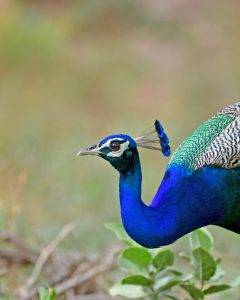
The Indian Peafowl is more than just a bird — it’s a symbol, a performer, a protector, and a national treasure. Whether you see it dancing in the rain, calling from a rooftop, or gliding down from a tree at sunset, it always leaves an impression.
So the next time you hear its echoing call or spot that shimmering flash of blue and green, take a moment to admire this regal resident of the Indian wild. After all, when nature puts on a show — the peacock is always centre stage.
| Get your favourite Indian Peafowl photograph framed for your wall – Request Now @+91-9540178459 |
